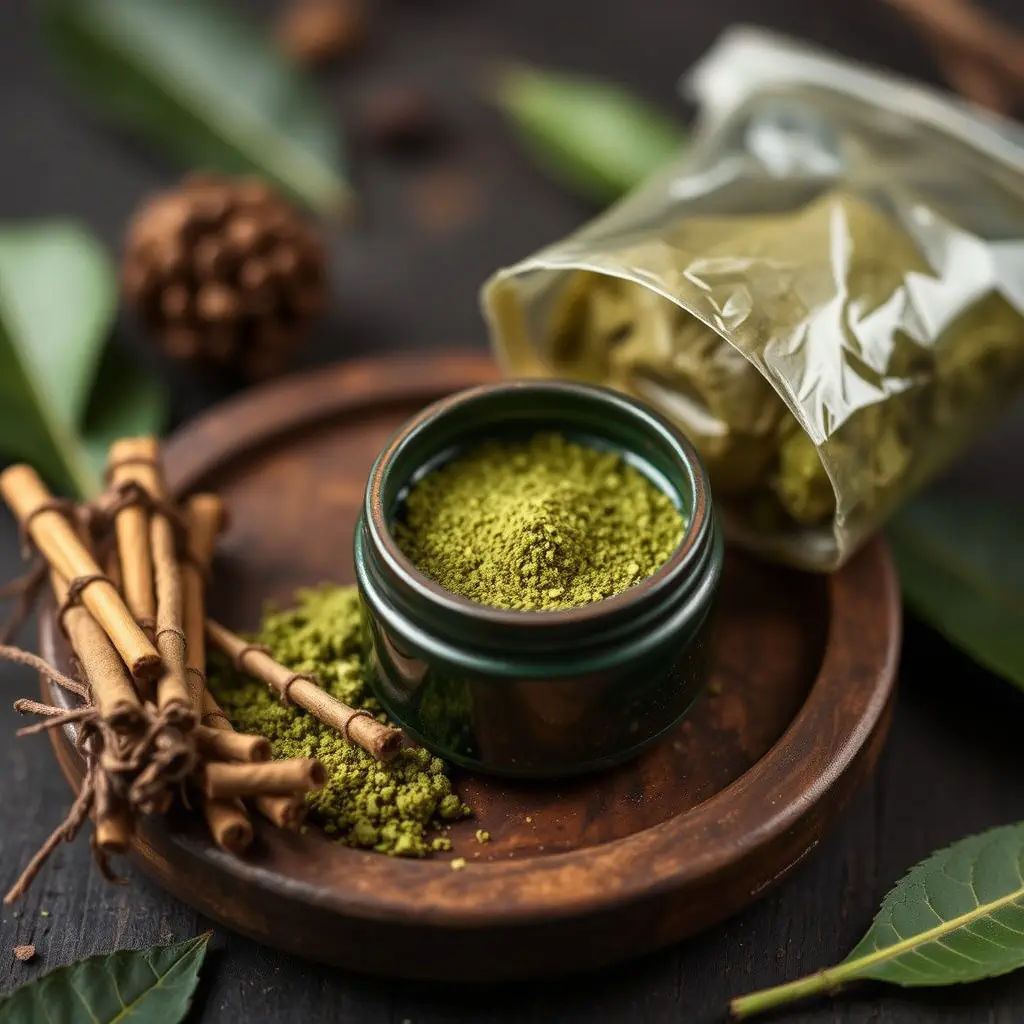Kratom, derived from the Mitragyna speciosa tree, has gained popularity as a natural aid for stress relief. Its alkaloids, such as mitragynine and 7-hydroxymitragynine, interact with opioid receptors to potentially influence mood and pain perception. The plant's effects can range from mild sedation to profound relaxation, depending on the dose and strain. Bali Kratom is favored for its calming properties, while Maeng Da Kratom offers a combination of relaxation and mental clarity. For optimal benefits, it's recommended to start with low doses, consider individual sensitivity, and take it after meals or during stressful periods. A holistic approach to stress management that includes exercise, mindfulness, balanced nutrition, and adequate rest can complement kratom for effective stress relief. Users are cautioned to consult healthcare providers before using kratom, especially if taking other medications, to ensure safe and responsible use. Kratom should be integrated into a wellness regimen as one component of a healthy lifestyle to achieve greater serenity and resilience against life's stressors.
Experiencing stress and seeking tranquility can be a challenge in today’s fast-paced world. An emerging topic of interest among those exploring alternative methods for relaxation is the use of kratom, a botanical substance that has garnered attention for its potential stress relief benefits. This article delves into how kratom may aid in stress relief and calmness induction, offering insights into selecting the appropriate strains and determining effective dosage. Additionally, it provides guidance on integrating kratom into a comprehensive stress management routine, ensuring readers are well-informed on this topic. Discover the role of kratom in promoting relaxation and how it can be a valuable addition to your wellness practices.
- Exploring Kratom's Role in Stress Relief and Calmness Induction
- Understanding Kratom Strains and Dosage for Optimal Relaxation
- Incorporating Kratom into a Holistic Stress Management Routine
Exploring Kratom's Role in Stress Relief and Calmness Induction

Kratom, a tropical evergreen tree native to Southeast Asia, has garnered attention in various wellness circles for its potential stress relief properties. Mitragyna speciosa, as it is scientifically known, contains alkaloids that may interact with the body’s opioid receptors, influencing mood and pain perception. Users often report that kratom aids in promoting relaxation and calmness, which can be particularly beneficial for those experiencing heightened stress levels. The plant’s effects are typically dose-dependent; lower doses might induce mild sedation and a sense of well-being, while higher amounts can lead to more pronounced calming effects. It is important for individuals to approach kratom with caution and to seek guidance from healthcare professionals before incorporating it into their stress management regimen, given its potential for interaction with other substances and its regulatory status in different regions. The role of kratom in stress relief is an area of ongoing research, with studies examining its alkaloid profile and the ways in which these compounds may influence neurotransmitters related to mood and relaxation. As such, kratom’s use for stress relief should be considered within a holistic approach to well-being, alongside other healthy lifestyle practices.
Understanding Kratom Strains and Dosage for Optimal Relaxation

Kratom, a mitragynoid derived from the leaves of Mitragyna speciosa trees, has been recognized for its potential to contribute to stress relief with kratom. The plant’s effects are influenced by the specific strains and their alkaloid profiles, which can vary significantly. When seeking relaxation and calmness through kratom, it’s crucial to understand the different strains available and how they might affect you. Bali Kratom, for instance, is known for its soothing properties, making it a popular choice for those looking to unwind. In contrast, Maeng Da Kratom is celebrated for its balanced effects that can promote relaxation without overpowering sedative qualities, which is ideal for users who wish to maintain mental clarity while achieving a state of tranquility.
Dosage plays a pivotal role in achieving the desired stress relief with kratom. The right dosage can fine-tune the effects to ensure a harmonious balance between relaxation and alertness. For beginners, it’s recommended to start with a lower dose to gauge individual sensitivity and then adjust gradually. A typical starting point for many is around 1 to 2 grams of kratom powder, which can be incrementally increased as needed. However, it’s important to always adhere to responsible usage guidelines and to be aware that each person’s optimal dosage may differ. Additionally, the timing of consumption can also impact its effectiveness; many users find that taking kratom after a meal or when experiencing heightened stress levels can enhance its relaxation benefits. As with any supplement, it is advisable to consult with a healthcare professional before incorporating kratom into your wellness routine to ensure it aligns with your personal health needs and circumstances.
Incorporating Kratom into a Holistic Stress Management Routine

Kratom, a botanical extract from the leaves of the Mitragyna speciosa tree, has garnered attention in holistic stress management routines due to its potential for stress relief with kratom. The alkaloids present in kratom leaves, primarily mitragynine and 7-hydroxymitragynine, are believed to interact with the body’s opioid receptors, which can influence mood and pain perception. When incorporated into a comprehensive stress management strategy, kratom may offer a natural alternative for those seeking relief from the pressures of daily life. It is important to approach its use with caution, as dosage and strain selection can significantly impact its effects; some strains are more stimulating, while others have a calming influence, which makes them suitable for relaxation and calmness.
To effectively incorporate kratom into a holistic stress management routine, it should be used in conjunction with other healthy practices. This includes regular exercise, mindfulness meditation, balanced nutrition, and adequate sleep. The combination of these elements can create a synergistic effect that enhances the overall benefits for stress relief with kratom. Additionally, it is crucial to maintain open communication with healthcare providers to ensure safe usage and to monitor any interactions with medications one might be taking. By integrating kratom thoughtfully into a well-rounded approach to wellness, individuals may find a path toward greater tranquility and resilience in the face of stress.
In this article, we’ve explored how Kratom can play a significant role in achieving relaxation and promoting calmness. By examining various strains and appropriate dosages, individuals can tailor their use of Kratom to complement a holistic approach to stress management. It is clear that incorporating Kratom into a balanced lifestyle may offer meaningful stress relief. For those interested in exploring the potential benefits of Kratom for relaxation, it is crucial to proceed with caution and seek guidance from healthcare professionals. As always, personal experiences with Kratom can vary, and understanding its nuances is key to harnessing its effects responsibly. With careful consideration and informed usage, Kratom may be a valuable addition to your stress relief arsenal.






